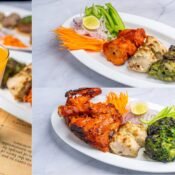
“Lokkhi Pujo Delights: Savory and Sweet Specialties for the Feast of Wealth”
Lokkhi Pujo, also known as Lakshmi Puja, is a cherished Hindu festival celebrated with great enthusiasm and devotion in various parts of India and among Hindu communities around the world. This auspicious occasion is dedicated to the worship of Goddess Lakshmi, the deity of wealth and prosperity. While the festival involves a range of rituals and customs, one of the most anticipated aspects is the special food that is prepared and shared during this time. Lokkhi Pujo special food is not just a culinary delight but a rich cultural tradition that adds a delicious dimension to the celebration.
- Khichdi – The Staple Dish: Khichdi is the quintessential dish of Lokkhi Pujo. This humble yet hearty dish is made by cooking rice and lentils together with spices and ghee. It is often considered the symbol of simplicity and purity. The preparation of khichdi varies from region to region, with some adding vegetables or different types of lentils, but the essence of this dish remains the same – it’s a warm and comforting food that is enjoyed by people of all ages.
- Luchi and Alur Dom: Luchi, deep-fried puffed bread, and Alur Dom, a spicy potato curry, are another classic combination that is an integral part of Lokkhi Pujo feasts. The golden, crispy luchis and the rich and spicy potato curry complement each other perfectly. They symbolize indulgence and are often prepared to celebrate the occasion with a touch of extravagance.
- Narkel Nadu and Sandesh: Lokkhi Pujo is also synonymous with sweet treats, and Narkel Nadu and Sandesh are among the most beloved. Narkel Nadu is a sweet made from grated coconut and jaggery, rolled into small round shapes. Sandesh is a delicate, soft, and fresh cheese dessert, often flavored with cardamom or saffron. These sweets are offered to Goddess Lakshmi as a part of the puja and later enjoyed by all as prasad.
- Misti Doi – Sweetened Yogurt: Misti Doi is a creamy and sweetened yogurt, a traditional favorite during Lokkhi Pujo. The natural sweetness of this dessert is enhanced by caramelized sugar, giving it a unique and delightful flavor. It’s often served in earthenware pots, adding to its authentic appeal.
- Chholar Dal and Radhaballavi: Chholar Dal, a rich and flavorful lentil preparation, is often paired with Radhaballavi, a stuffed flatbread. This combination is not only delicious but also showcases the variety of flavors and textures found in Bengali cuisine. The indulgent and savory nature of these dishes adds a special touch to the festival feast.
- Pitha – Rice Cakes: Pitha, a variety of rice cakes, is an essential part of Lokkhi Pujo celebrations, especially in the eastern regions of India. There are various types of pitha, including Patishapta, Puli, and Kakara, each with its unique taste and preparation. These rice cakes are made with rice flour, jaggery, and coconut, making them a sweet and cherished treat during the festival.
- Fruit Offerings: Fresh fruits, especially seasonal ones, are also an important part of Lokkhi Pujo offerings. They symbolize the natural abundance and prosperity that Goddess Lakshmi is believed to bring. Fruits like bananas, coconuts, and pomegranates are commonly offered during the puja.
- Traditional Drinks: Lokkhi Pujo is also an occasion for special drinks. People enjoy beverages like Sattu, a nutritious roasted gram flour drink, and Aam Panna, a sweet and tangy mango drink. These beverages provide a refreshing contrast to the rich and spicy dishes.
In conclusion, Lokkhi Pujo is not just a religious or cultural event; it is a celebration of the senses, where the aroma, taste, and presentation of the food play a pivotal role. The special food prepared during this festival is a testament to the rich culinary heritage of India and is deeply intertwined with the spiritual and cultural significance of the occasion. It brings families and communities together, making Lokkhi Pujo a truly delicious and heartwarming celebration that is cherished by all.



